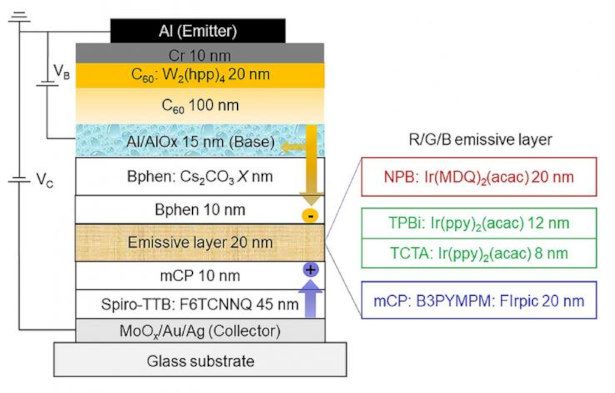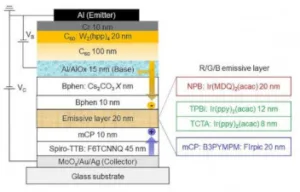A team of researchers headed by Zhongbin Wu of Dresden Technical University (Dresden, Germany) are working on increasing the performance of organic materials and devices for use in a range of applications that includes flexible optoelectronics.

The approach adopted by the team is based on organic light emitting transistors. These are three terminal devices that combine a highly efficient, thin film switching transistor with a light emitting diode. This type of device is commonly employed in active matrix displays. More specifically, the team investigated a new device structure that combines vertical organic permeable base transistors (OPBT) and OLED materials. The name given to the new device structure is organic permeable base light emitting transistor or OPB-LET. A key factor in the development process was the goal of increasing efficiency while maintaining a low operating voltage.
A recent article on this topic by the team is entitled “Efficient and low-voltage vertical organic permeable base light-emitting transistors.” It was published on-line on March 1 in Nat. Mater. (2021). A copy of the article is available for purchase here.
As reported in this article, the team determined and demonstrated that a key to high performance in OPB-LETs is a nano-pore permeable base electrode located at the center of the device. “The electrode forms a distinctive optical microcavity and regulates charge carrier injection and transport.” The configuration of the device developed by the team is illustrated in the figure below.
 The device architecture of an organic permeable base light emitting transistor.
The device architecture of an organic permeable base light emitting transistor.
During the course of the development process, the researchers produced prototypes of several types of three terminal vertical optoelectronic devices. Specific prototypes were designed to emitted red, green or blue light. Operating at low driving voltages of less than 5.0 volts, the devices achieved the following properties.
- Red: external quantum efficiency of 19.6%, current efficiency of 20.6 cd/A and a maximum luminance value of 9,833 cd/m²
- Green: external quantum efficiency of 24.6%, current efficiency of 90.1 cd/A and a maximum luminance value of 12,513 cd/m²
- Blue: external quantum efficiency of 11.8%, current efficiency of 27.1 cd/A and a maximum luminance value of 4,753 cd/m²
These performance specifications are comparable to state-of-the-art OLED devices – but achieved with low voltage, organic transistors.
Two videos are appended to the end of this article. Although very little seems to be going on in these videos, the presentations are significant when it is understood what is actually being demonstrated. The first video demonstrates the on/off switching function of an OPB-LET. The second video illustrates luminance variation in an OPB-LET.
The researchers closed their article with the statement that:
“We expect that this novel device principle will pave the way for highly efficient flexible displays with a rather simple pixel design.”
-Arthur Berman
Dresden Technical University, Erjuan Guo, [email protected]

